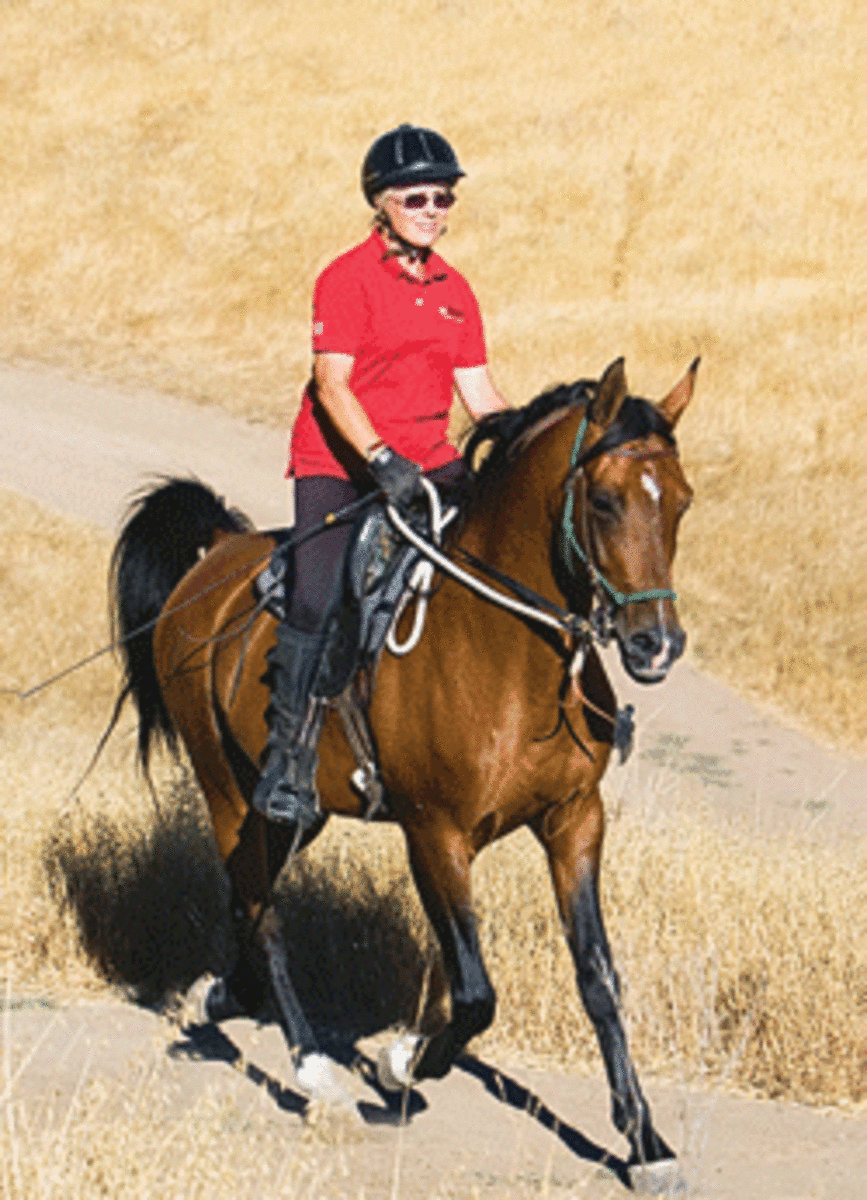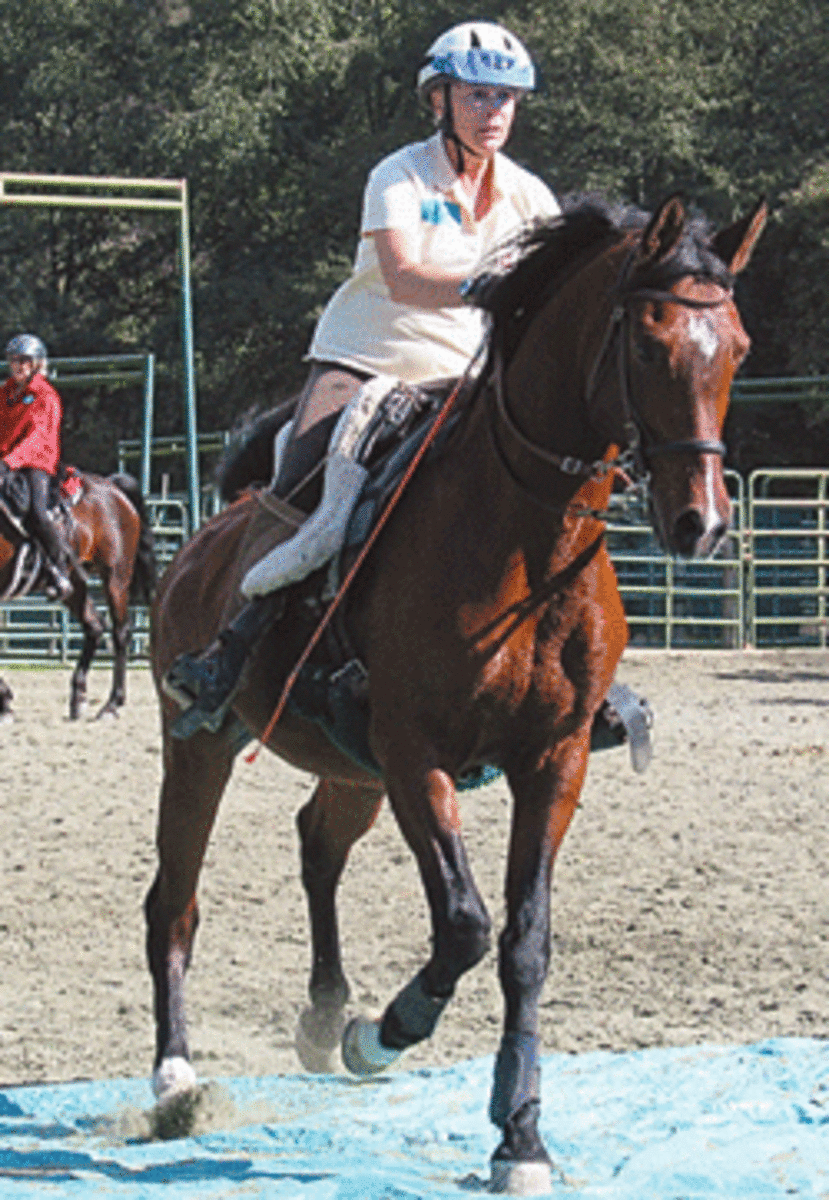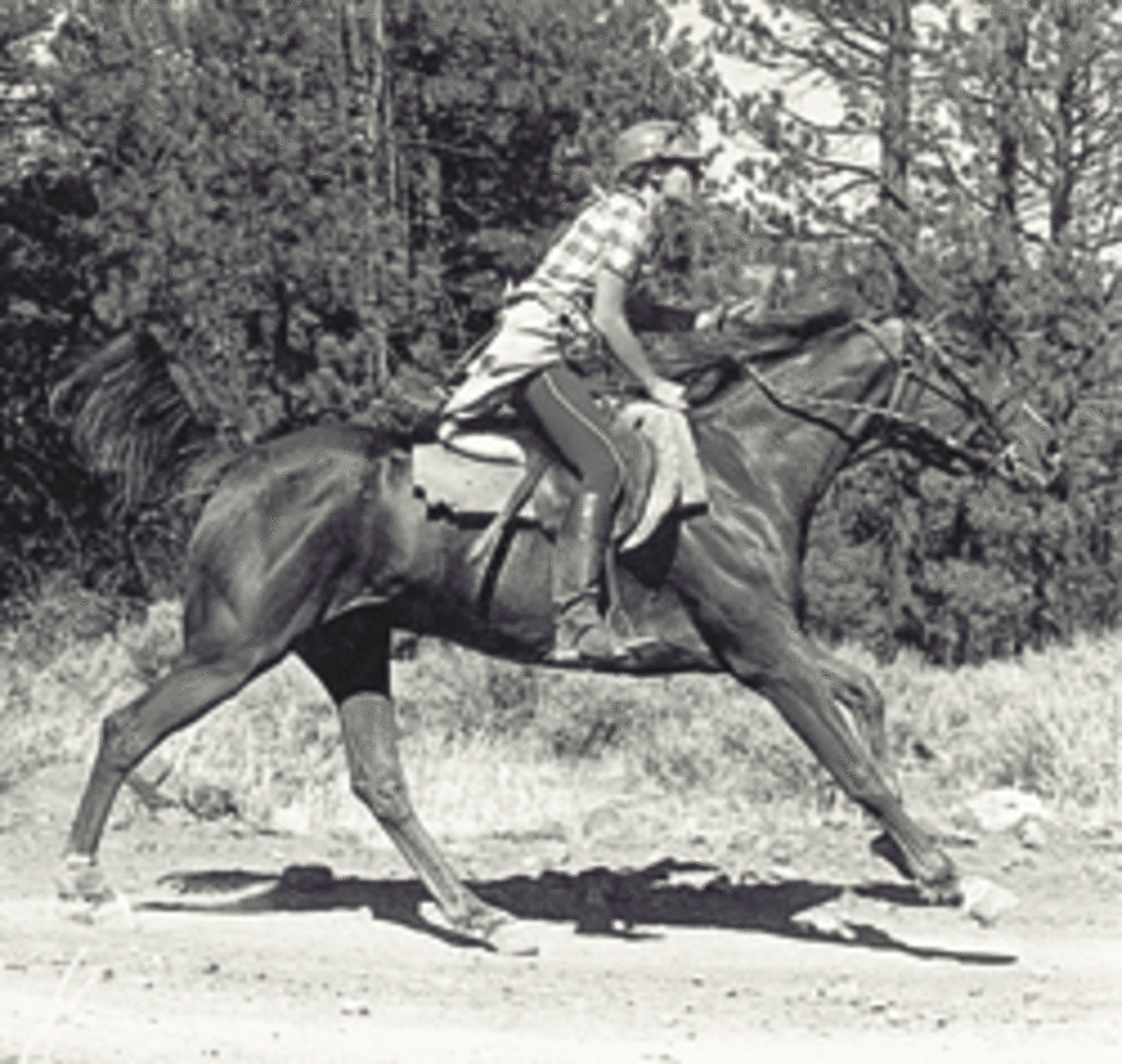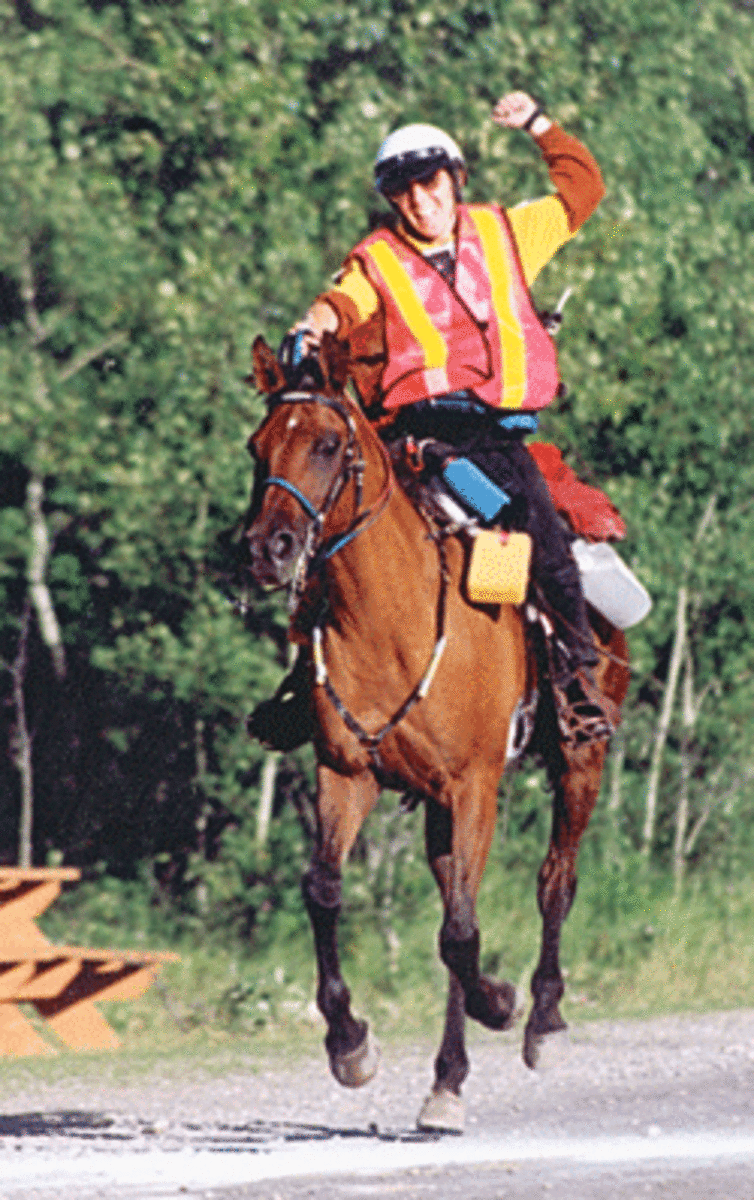
Becky Hart was born loving horses and started riding lessons shortly after she started kindergarten. For the past 30 years, her passion has been endurance riding, and she’s become one of the top competitors – not just in this country, but in the world. Many times, Hart has represented the United States, and many times she’s made us proud.
She’s traveled more than 20,000 competitive miles en route to the American Endurance Ride Conference Hall of Fame, and twice won both the grueling Tevis Cup: 100 Miles-One Day Ride and the Race of Champions. Hart was also the AERC National Champion twice and is the only rider to have won the prestigious World Endurance Championship three consecutive times. Her many accomplishments earned her the United States Equestrian Team’s Equestrian of the Year title.
In addition, Hart has a penchant for teaching. She’s a Level III Centered Riding instructor, and for more than 20 years she’s shared techniques for balanced, natural riding, and ground work at clinics and seminars across the country.
Having achieved so much, is she ready to slow down or rest easily on her laurels? Not any day soon!
“I’d like to compete in at least one more World Endurance Championship, perhaps in Kentucky in 2010,” Hart says with a smile. “I have a terrific horse named II Damb Much, a.k.a. Buddy, who has the talent to do it. Ultimately, I’d like to have a multidiscipline facility, and incorporate TTeam work, natural horsemanship, and Centered Riding to teach riders of all abilities and disabilities. I really enjoy teaching. And there are books to write, and a website to develop.”
Read on to meet an extraordinary trailblazer, Becky Hart.
TTR: What was your first up-close-and personal experience with horses?
Hart: I started riding lessons at age 6, with a patient and willing school horse named Lucky. At my very first lesson, the kids in front of me got to trot, and I remember wanting to trot, too! My first trail ride was onboard Lucky, into the Santa Cruz Mountains of California. At one point, a car came around a corner, scared my horse, and I fell off. I wasn’t hurt or afraid, but my instructor, Mrs. Knight, yelled at the driver, and that made an impression.
TTR: Tell us about your first horse.
Hart: When I was 11 years old, my parents bought me a Quarter Horse gelding named Tiberon. He was patient, although certainly had his own opinions. He loved dashing under low-hanging tree branches, and he tested me at first. Tiberon taught me lots, especially that I needed to provide clear intention in what I asked of him. During the summer, my cousin and I would ride him from morning till night.
TTR: How did you become involved with endurance riding?
Hart: When I was 14 years old, I fell in love with a three-quarter Arabian that boarded at the same stable where we kept Tiberon. His name was Nusan, and he was just 2 years old when I got him. Eventually, he went to a trainer, and then I showed him successfully in just about every class possible: English and Western pleasure, equitation, Arabian costume, and trail.
In time, I met a rider at the same stable who owned a Tennessee Walker and rode endurance. I crewed for her at the 50-mile Castle Rock Ride, and afterwards I loaned Nusan to another endurance rider for a competition. They finished respectably, which made me think that perhaps I should give endurance a try.
TTR: What about endurance captured your imagination?
Hart: The next spring, I entered the Castle Rock Ride with Nusan, and finished 68th – using a Western saddle! Even though I couldn’t walk for three days, just making it to the finish line felt really great. AERC has a saying, “To finish is to win.” My horse was completely happy throughout that ride, and I discovered that I enjoyed going fast, too. It opened up a whole new world for us, and our show days came to a screeching halt.

TTR: Why do most riders compete in endurance?
Hart: To spend time enjoying their horses on great trails, often on private land not normally open to riders. Also, to improve their horsemanship skills.
TTR: Two of your horses have been inducted into the AERC Hall of Fame. Tell us about the first, Arabian Horse gelding Khazen.
Hart: I first met Khazen when he was a 5-year-old, but because he seemed spooky, I didn’t really like him. That is, until three years later, when I rode him on an endurance ride and we won. During several rides that followed, I realized what a good horse he was: We entered six rides, and won six. The next year, I decided to go for the AERC National Championship, and we won 17 of the 22 rides we entered.
Khazen had tons of heart and wanted to win. And he was a real character. He was always very businesslike and didn’t like people making a fuss over him: When a ride was over, he wanted to be left alone with his food.
Eventually, he bowed a tendon while playing out in the pasture and needed to slow down a bit. He took a couple of people on the Tevis, and at 14 years old, I loaned him to a family to become their children’s horse. When the kids were grown and he was 28, I brought him back home, and for the next four years he was my lesson horse. He loved kids, and I could trust him with any child. I appreciated Khazen lots more in his old age.
TTR: What about one of the most accomplished and beloved endurance horses ever, Arabian Horse gelding RO Grand Sultan, a.k.a. Rio?
Hart: When Khazen bowed his tendon, I had to find another endurance horse. I went to see one prospect who’d had some top-10 success in endurance, and the owner said that they’d give me a second, untried gelding for free. Both went home with me. When I entered the experienced horse in a 50-mile ride, he quit at 45 miles, and we walked to the finish. At the next ride, again he just quit. So I sold him.
On the other hand, Rio liked to go. Early on, there were rocky moments: When the president of AERC looked at Rio, my horse tossed his head and broke the man’s glasses, and later his trainer rejected Rio because he was pigeon-toed.
Our first competition was the Mount Diablo 50-Mile Ride. We went into the first vet check in 60th place, but Rio recovered his normal pulse and respiration so fast, that we left in 15th place. During that ride, I discovered that Rio hated to have horses ahead of him and wasn’t satisfied until he was in front. But it was his fast recoveries at our scheduled stops that gave us a win. It was a big eye opener!
TTR: Was there a reason for his fast recoveries?
Hart: Yes. Later, I learned that his heart was an amazing organ, averaging 94 percent efficiency, as opposed to the 75 to 78 percent efficiency that horses normally have. It pumped more oxygen to his muscles and cleared lactic acid faster, which allowed him to recover from exertion much more quickly.
That first year, we won four of five rides leading to the Tevis, then we won the Tevis Cup. Rio absolutely knew when he won, and he wanted to win. Throughout his life, he had a wonderful sense of humor and loved to play tricks on us. He had a twinkle in his eyes when he sauntered into a cow pond (with my partner, Judith, onboard) then lay down!
TTR: You must have many special memories of Rio.
Hart: So many. Once at a Linda Tellington-Jones’ TTeam clinic, Penelope Smith, an animal communicator, “talked” with Rio. He’d been eating, but stopped when she approached. She didn’t know his story, but I’d requested that she ask him if his feet ever hurt. She said that he told her, “No, never. You could cut my feet off, and I’d still want to race. Becky and I are a team, and together we can accomplish anything.”
Rio raced until he was 21, then he became my lesson horse. He had a great life. He was 27 when he died of lymphoma.

TTR: What qualities do you most value in your horses?
Hart: A good mind; excellent conformation; the heart and desire to win; and good pulse-and-respiration recovery times – which may be genetic, but can improve with conditioning. All of these qualities are important in a pleasure horse, too. Whatever you want to do, your horse should do it with enthusiasm and vigor. We all should ride horses that we enjoy.
TTR: Describe a typical trail ride when your goal is to condition your horse.
Hart: To warm up, I always start with a 15 to 20 minute walk, combined with leg yields and half-halts to get my horse supple. Three times a week, I ride five to eight miles, depending on my horse’s level of fitness, his age, and the terrain. I walk and trot, rarely cantering. Downhill, I walk or, if it’s really steep, I get off and lead.
As my horse becomes fit, I’ll ride 8 to 14 miles, with one 20-mile ride per week, keeping in mind that horses aren’t ready, physically or mentally, for an intense training program until they’re 8 years old.
TTR: What’s your favorite ride?
Hart: The Swanton Trail in the Santa Cruz Mountains of California. We ride amongst giant redwoods and along the coast. It’s fantastic!
TTR: What was your most challenging endurance ride?
Hart: It was in 1992, at the World Endurance Championships in Spain. It wasn’t so much the physical challenge of the 100-mile course, but that so many things went wrong! Rio and I were third into the first vet check, and he was the first horse to recover. But when we trotted out, we could see a rider ahead: Someone had mistakenly let a French rider go too soon. Friends radioed me that she would be penalized at the next vet check, but that never happened.
Meanwhile, Rio lost a shoe. I put on an Easy Boot, which worked until it somehow came off and wrapped itself around his ankle. Fortunately, I had a Leatherman’s tool to cut it off and another Easy Boot to replace it. That took five valuable minutes, and the French rider was even farther ahead. At the next stop, a farrier put on new shoes, and Rio left at a gallop – his sense of humor again!
He worked so hard: over lava fields, through small villages, and past pig farms. We made up lots of time and finally reached the finish line, which was on a big polo field. We entered the field in first place, but because there were groves of shade trees and Rio was bay, people didn’t see us. No one clapped, so I knew my crew hadn’t seen us either. Then, the French rider entered – on a gray horse, which the crowd spotted – and people clapped. It wasn’t until Rio and I were halfway around the field that my crew finally saw us and roared. At last, they knew that we’d won! It felt great.

TTR: What can pleasure riders learn from endurance riders?
Hart: How to pace yourself and your horse from point A to point B, all the while being aware of his healthy pulse, respiration, warm up/cool down, and nutritional needs.
TTR: What can endurance riders learn from pleasure riders?
Hart: How to take the time to enjoy the beauty of where we ride, and to have fun.
TTR: What’s the greatest lesson horses have taught you?
Hart: To always keep my sense of humor. And not to be surprised if, as soon as you think things are going well – they don’t.
TTR: How can Centered Riding enhance a rider’s experience?
Hart: The better balanced you are, the better ride you’ll have. Centered Riding improves balance and helps you move with your horse in a more fluid manner. It’s about feel and developing a oneness with your horse.
TTR: What three qualities do you value in a friend?
Hart: Honesty, humor, and an appreciation of horses for what they do.
TTR: What’s the best book you’ve read recently?
Hart: The Time of Our Singing by Richard Powers. His story about a mixed-race family in the 1950s pulled me right in. His writing style is amazing.
TTR: What’s your most valued possession?
Hart: My photos, and my videos of Rio at the two world championship rides.
TTR: Complete this sentence: People would be surprised to know that I…
Hart: ….used to go slow, and show horses on the rail – all disciplines.
TTR: If you could invite anyone – from any era – to talk around a campfire, who would you chose?
Hart: I love to read, so I’d invite author Dick Francis. He has so many engaging stories from his racing days, there wouldn’t be a dull moment.
TTR: What is your idea of perfect happiness?
Hart: Perfect happiness is a fleeting state, like balanced riding: treasured for a moment, then gone.But it would have to include work that I love, a partner who is my soulmate, and – of course – horses.






